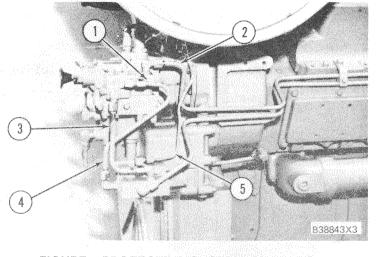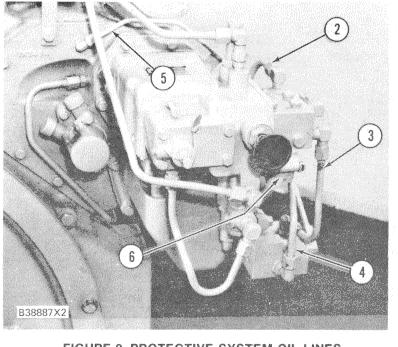
6 minute read
3500 Industrial Engines
SCHEMATIC NO. 19 (REMOTE NORMAL SHUTOFF) 15. Diverter valve orifice. 16. Remote normal shutoff valve. 17. Fuel shutoff actuator. 18. Diverter valve. 20. Start-up override valve.
REMOTE NORMAL SHUTOFF
Make Reference to Schematic No. 19
The remote normal shutoff is an option that can be used with the hydramechanical protective system. An air or electric operated remote normal shutoff valve ( 16) is installed in the diverter valve return line. When remote normal shutoff valve (16) is operated, the outlet of the diverter valve is stopped. The oil pressure becomes equal on both sides of diverter valve orifice (15). Spring force will move the valve spool of diverter valve (18) to make an alignment of the oil passage with the oil line to fuel shutoff actuator (17). Oil pressure can now activate fuel shutoff actuator (17), which causes the governor to move the fuel control linkage to the "SHUTOFF" position and shutdown the engine.
238
TROUBLESHOOTING
Troubleshooting can be difficult. On the following pages there is a list of possible problems. To make a repair to a problem, make reference to the cause and correction.
This list of problems, causes, and corrections, will only give an indication of where a possible problem can be, and what repairs are needed. Normally, more or other repair work is needed beyond the recommendations in the list.
Remember that a problem is not normally caused only by one part, but by the relation of one part with other parts. This list can not give all possible problems and corrections. The serviceman must find the problem and its source, then make the necessary repairs.
TROUBLESHOOTING INDEX
Item
1. Engine Will Not Start. 2. Engine Will Start, But Shuts Down When Oil
Pressure Override is Released. 3. Engine Will Only Run Below 70% of Rated Speed. 4. Air Inlet Shutoff Activates on Load Rejection. 5. Air Inlet Does Not Close. 6. Engine Will Not Restart After Operation of
Emergency Manual Shutoff. 7. Engine Will Not Shutdown When Checking Low
Engine Oil Pressure Protection Circuit. 8. Shutoff Control Unit Does Not Operate.

FIGURE 1.PROTECTIVE SYSTEM OIL LINES
1. Plug. 2. Oil line to thermostatic pilot valve. 3. Oil return line from diverter valve. 4. Oil supply line to diverter valve. 5. Oil drain line from diverter valve. FIGURE 2. PROTECTIVE SYSTEM OIL LINES
2. Oil line to thermostatic pilot valve. 3. Oil return line from diverter valve. 4. Oil supply line to diverter valve. 5. Oil drain line from diverter valve. 6. Cover on actuator valve body.
Problem

239
1. ENGINE WILL NOT START
Cause Correction
Engine Start-Up Override Not ByPassing Oil Pressure By Shut- off Control Group To Drain
Fuel Shutoff Actuator Stuck In The Shutoff Position Disconnect drain line (5), See Figure 1. Operate the override (push button switch for electric, push button valve for air) and crank the engine. Oil should flow from drain line. If not, inspect the solenoid or air operated two-way valve and the push button switch or push button air valve and lines.
Make sure that the start-up override system is operating correctly. Operate the start-up override and crank the engine. Check the governor linkage and fuel control linkage to see if they are in the run position. If not, check the shutoff actuator for binding.
2. ENGINE WILL START, BUT SHUTS DOWN WHEN START-UP OVERRIDE IS RELEASED
Cause Correction
Engine Oil Pressure Is Too Low
Engine Oil Pressure Sensing Orifice Plugged
The Oil Return Line Between Diverter Valve And Shutoff Control Group Is Plugged
Remote Normal Shutoff Still Activated
Engine Oil Pressure Is Drained Through Thermostatic Pilot Valve
Engine Oil Pressure Sensing Portion Of The Control Group Has Malfunctioned Install a pressure gauge in oil line (2) or in port ( I ) behind oil supply line (4), see Figure 1. Operate the start-up override and start the engine. Engine oil pressure must be 175 kPa (25 psi) minimum at low idle and 240 kPa (35 psi) minimum at rated speed.
Remove the control group from the engine to disassemble and clean orifice if necessary.
Disconnect oil return line (3) at the shutoff control group, see Figure 1. Crank the engine without using the start-up override valve. Oil should flow out of the oil return line. Check the oil line for damage and clean or replace as needed.
Disconnect oil return line (3) at the shutoff control group, see Figure 1. Crank the engine without using the start-up override valve. Oil should flow out of the oil return line. If there is no oil flow and the line is not plugged or damaged, check the remote normal shutoff system. Make a repair or replacement of worn or damaged parts and clean the valve if necessary.
Check drain side of valve. Replace valve, if flow is present at cranking and engine coolant temperature is normal.
Remove cover (6), see Figure 2. Inspect the valve spools in the actuator valve body to make sure valves are not stuck. Replace cover (6) after inspection.
Check the engine oil pressure. Install a pressure gauge in oil line (2) or in port (1) behind oil supply line (4), see Figure 1. Operate start-up override and start the engine. If the engine oil pressure is equal to or greater than 175 kPa (25 psi) at low idle and 240 kPa (35 psi) at rated speed, replace-the oil pressure sensing group (part of the shutoff control group).
actuator valve body to make sure valves are not stuck. Replace cover (6) after inspection.
240
3. ENGINE WILL ONLY RUN BELOW 70% OF RATED SPEED
Cause
Engine Oil Pressure Is Not High Enough In The High Speed Range
Correction
Check engine oil pressure in oil line (2), see Figure 1. A minimum of 240 kPa (35 psi) is required in high speed range. Clean the engine oil pressure line to the shutoff control group, if needed. Also, engine repair may be needed.
4. AIR INLET SHUTOFF ACTIVATES ON LOAD REJECTION
Cause Correction
Governor Overshoot Lets Engine Speed Exceed Overspeed Setting Correct governor overshoot. If this can not be done, increase over- speed setting to a maximum of 25% of rated speed.
5. AIR INLET DOES NOT CLOSE
Cause Correction
Tube Fittings At Hydraulic Actuator Are Installed Too Far. The End Of The Fitting Is Binding The Cylinder Rod
Air Inlet Valve Shaft Sticking Or Binding Turn fittings out until cylinder rod is free to move.
Check for corrosion on shaft bearing surfaces or improper alignment.
6. ENGINE WILL NOT RESTART AFTER OPERATION OF EMERGENCY MANUAL SHUTOFF
Cause
The 5N5880 Remote Emergency Manual Shutoff Did Not Fully Return To The Run Position When Switch Or Valve Was Released
Fuel Shutoff Actuator Stuck In The Shutoff Position
Air Inlet Valve Shaft Sticking Or Binding Check for binding of 5N5878 valve in the valve bore.
Remove the actuator. Check surface finish of bore and polish, if necessary. Put a small amount of clean oil in the bore and on the seal. Move the rod and piston in the actuator cylinder to check for free movement. Replace actuator, if necessary.
Check for corrosion on shaft bearing surfaces or improper alignment.





